“Genome to phenome”
(Extremophilic Bioprocessing Laboratory – Professor Rajesh Sani)
The Extremophilic Bioprocessing facilities (Sani Group) at the Department of Chemical and Biological Engineering at SDSM&T provides about 2000 ft2 of laboratory space, housing equipment for conducting microbiological, biochemical, as well as omics research. From working with plasmid mini preps to vectors, the labs are equipped with a comprehensive line of centrifuges, incubators, spectrophotometers, sterilization solutions, anaerobic chambers, electrochemical and gravitational workstations, and also fermentation bioreactors for controlled cultivation of microorganisms. Their CBE lab is also equipped with a range of molecular DNA and RNA research equipment including PCR, RTPCR, and some dedicated bioinformatics software’s for in-silico studies like AutoDock Discovery Studio (BIOVIO). The Sani group has recently been awarded a RII-T1 Building on the 2020 Vision: Expanding Research, Education, and Innovation in South Dakota (NSF# 1355423) to create a “South Dakota Biofilm Science and Engineering Center” The main goal of this “Meta-omics engineering center” is to develop new methodological approaches in the field of genomic and post-genomic technologies, bioengineering and genetic engineering, system, synthetic and structural biology. The required purchasing for this center has already started, which includes an Oxford Nanopore’s MinION, and CLC workstation, in order to facilitate multi-omics research
Basic Microbiology and Biochemical research
Professor Sani’s Extremophilic Bioprocessing Lab’s offer equipment’s to meet the microbiology needs. From working with plasmid mini preps to vectors, the lab is equipped with a comprehensive line of centrifuges, incubators, spectrophotometers, and sterilization solutions. The microbiology laboratory also provides biological safety equipment to ensure the protection of laboratory personnel.
Processing Equipment
Centrifuges and Incubators
- High speed centrifuge (Sorvall, RC-26 plus
- Table-Top Centrifuges (Eppendorf 5810R, Sorvall T6000B)
- Beckman ultracentrifuge and nVTi90 rotor
- Water-bath incubators (Thermo Scientific)
- Multiple-temperature shaker/incubators (New Brunswick, Innova 44/44R
Sterilization, Lysis and Freezing, Bacterial Preservation/Storage, and Biosafety
- Autoclave (Consolidated Stills & Sterilizers)
- Sonicator (Kimble/Kontes)
- Freeze dry/shell system (Labcono)
- Purifier Logic+ Class II, Type A2 Clean bench system
Fermentation Reactors and Anaerobic Processing
- Benchtop reactor (Four 1L reactor vessel)
- 40 BIFLO 510 reactor (Eppendorf)
- Custom-built 200L bioreactor
- 55-gallon Digester
- Anaerobic chambers
- Anaerobic GasPack systems
Characterization and Testing Equipment’s
Spectrophotometers:
- Spectrophotometer (Beckman Coulter DU 640)
- Spectrophotometer (HP 8452A, UV/VIS)
- Microplate Elisa Reader
Microscopes
- Microscope (Optical Olympus)
Chromatographic Analysis
- High Pressure Liquid Chromatography (Shimadzu- I series LC2030)
- Liquid Chromatography-Mass spectroscopy (Shimadzu- I series LC2030 LT)
“Genome to Phenome” Research
Molecular DNA Research
- DNA sequencing gel electrophoresis kits and accessories
- Electrophoresis apparatus (horizontal and vertical)
- Bead-beater
- Electroporator (BioRad)
- Lyophilizer (Labcono)
- PCR thermocyclers (Perkin Elmer 480, 9070, BioRad)
- Gradient PCR (Eppendorf)
- Thermo Forma PicoReal RT PCR (Applied Biosystems)
- Nanodrop 2000CW (Thermo Scientific)
- Foto/analyst archiver system (Fotodyne)
Protein Research
- SDS PAGE assembly (BioRad)
- Protein Purification equipment
In-silico Studies
Licensed access to several bioinformatics software, including:
- AutoDock Discovery Studio (BIOVIO)
- ClustalW & SWISS-MODEL
- Computational server (Dassault)
Note: For recombinant DNA technology and protein engineering work, all of the required plasmid, cloning vectors, expression vectors, restriction enzymes, and competent cells etc. are well stocked and maintained regularly.
Electrochemical workstation: It helps to develop bioelectrocatalytic systems such as microbial electrolysis, electro-fermentation, and microbial electrosynthesis. The system also helps to identify the redox potential of the microorganisms and develop microbial biosensors for different applications.
Gravitational Workstation
- NASA Bioreactor
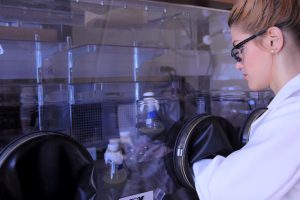
Anaerobic Chamber:
Anaerobic chambers, also known as anaerobic glove boxes, is an atmosphere control unit designed to be used when working with oxygen sensitive materials, product containment needs, and/or general isolation control. Anaerobic chambers significantly improve culturing and identification. They also reduce consumable costs typically experienced with the use of anaerobic jars or bags.
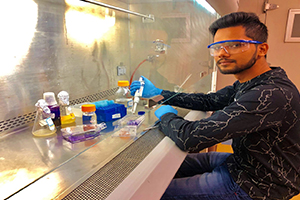
Clean Bench System
The clean bench is recommended for work with non-hazardous materials where clean, particle-free air is necessary to avoid contamination. The clean bench ensures that the work surface is constantly flooded with HEPA-filtered air in a laminar flow. The HEPA air filter can trap 99.999% of particles with a diameter greater than and less than 0.3 micron. Proper enclosure design helps prevent backwash and ensures that the vertical or horizontal laminar air flow continues to protect work on the surface of the clean bench.
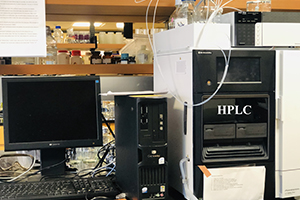
Liquid Chromatography
LC: This includes a dedicated HPLC systems used for a variety of applications including, analysis of organic compounds, anion analysis, analysis of microbial products, etc. Equipment also includes an HPLC radioisotope detector. In addition, a bench-top mass spectrometer is available to the project (LC/MS).
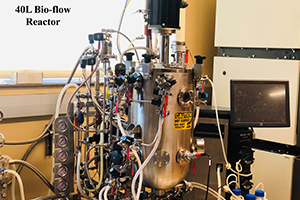
40L BIFLOW 510 Reactor (Eppendorf)
BIOFLOW 510 is a modular fermentation system for microbial and cell culture applications. It is a versatile fermenter/bioreactor that provides a fully equipped system in one compact package. It can be employed for batch, fed batch or continuous culture with process control for pH,dissolved oxygen (DO), agitation, temperature, pump feed, antifoam and foam/level.
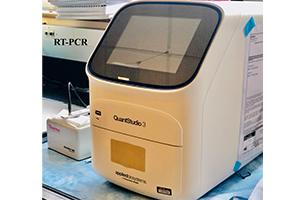
RT-PCR
Real-Time PCR Thermal Cyclers/ Thermocyclers, also referred to as Quantitative PCR (qPCR) calculate PCR amplification as it occurs. Using smaller amounts of starting material and combining nucleic acid amplification and detection allows for efficiency and eliminates the post-amplification process. Real-time PCR thermocyclers can be used with both DNA and RNA. When using RNA, reverse transcriptase is used to quantify the amount of RNA in the starting sample. Relevant applications include quantitative gene expression analysis, SNP analysis, drug target validation and genotyping.
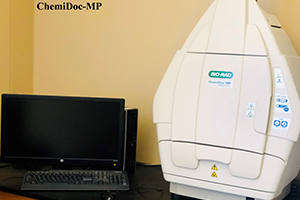
ChemiDoc-MP SYSTEM
The ChemiDoc Gel Imaging System is the fastest detection system for chemiluminescence, fluorescence, and colorimetric imaging. Controlled by Image Lab Image Capture and Analysis Software.
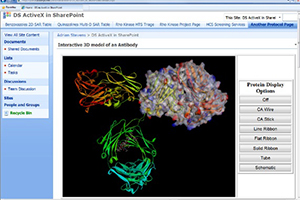
Discovery Studio (BIOVIO)
Discovery Studio is a suite of software for simulating small molecule and macromolecule systems. Molecular visualization is a key aspect of the analysis and communication of modeling studies. BIOVIO studio enables a mechanistic understanding of a molecule’s structure to be visualized, so that key insights can be shared between computational modeling experts and collaborating team members.
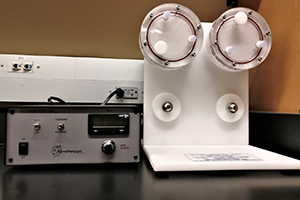
Microgravity Reactor
Growth of cells have been performed in stagnant broth for ages. This technique has been proven inefficient, as the cells tend to flocculate and settle, leading to deficiency and non-uniformity in nutrient supply to the cells. Rotating bioreactor solve this problem, as the environments exhibit “microgravity,” and the cells remain suspended in the fluid.
